The iPhone XS & XS Max Review: Unveiling the Silicon Secrets
by Andrei Frumusanu on October 5, 2018 8:00 AM EST- Posted in
- Mobile
- Apple
- Smartphones
- iPhone XS
- iPhone XS Max
Display Measurement
Apple first introduced OLED panels in the iPhone X last year – and this year’s iPhone XS and XS Max are a continuation of the same designs. The XS’s panel ticks off all the features that are possible to have in a display – OLED, high resolution, wide gamut with colour management, and HDR display with official support of HDR10 and Dolby Vision. The panel is manufactured by Samsung Display, but is said to be a contracted design as blueprinted by Apple.
Among one of the questions I’m still asking myself, is who designed and is providing the display’s DDIC? OLED displays' DDICs are even more important than LCDs', because they not only control colour, but also have to control the active matrix power delivery, and thus the DACs that actually power on the individual pixels.
The iPhone’s display is still a scanning PWM powered panel, meaning the pixels are not actually continuously on, but pretty much work the same way a CRT beam would work – only instead of a single pixel, we have a partial vertical band across the display. The reason for this is just the sheer complexity of running the active-matrix: each subpixel needs to be controlled to 1024 voltage levels to represent the colours of the 10-bit panel. On top of that, the DACs need to have sufficient bit-depth to also provide a seamless range of brightness levels. Here saving on the DAC bit-depth by controlling brightness by PWM is a good workaround the issue.
The iPhone XS’ displays are really excellent at first sight, offering fantastic viewing angles. Personally however, I still have some reservation about the bezel design; Apple has been bested when it comes to screen-to-body ratio by other Android vendors, and I expect to see even more devices come out with what are true full device face screens.
The display’ pixel density doesn’t quite match other 1440p smartphones in terms of sharpness, but it’s still plenty sharp enough for the vast majority of people.
As always, we thank X-Rite and SpecraCal, as measurements are performed with an X-Rite i1Pro 2 spectrophotometer, with the exception of black levels which are measured with an i1Display Pro colorimeter. Data is collected and examined using SpectraCal's CalMAN software.
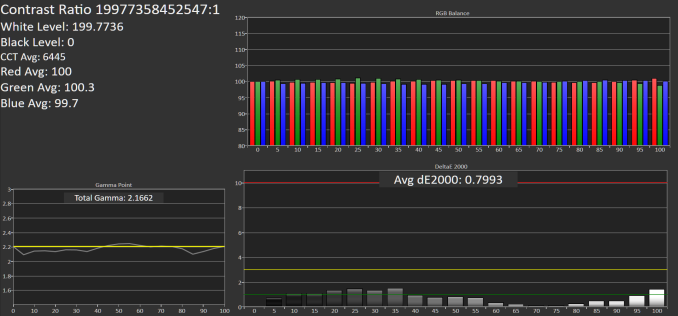
SpectraCal CalMAN
XS :
XSM:
In terms of greyscale accuracy, both the iPhone XS and iPhone XS Max present outstanding accuracy, coming in at an astonishing deltaE2000 of 0.79 for the XS and 1.64 for the XS Max. My Max unit seemed to lack intensity in the green channel, which reduced its accuracy score.
Both phones came in very close to the target 6500K of the D65 illumination point, in practice they’re very much perfect white.
Brightness wise, my XS maxed out at 646cd/m², while my XS Max came in at 668cd/m². There is no auto-brightness boost, however at such high brightness levels, there’s no need. Minimum brightness goes down to a little under 2 nits, allowing for comfortable night-time reading.


iPhone XS - iPhone XS Max
SpectraCal CalMAN
If one were to nit-pick, then it’s about the gamma measurement as the XS seemed to undershoot the 2.2 target, resulting in ever so slightly darker images, while my XS Max overshot it, resulting in brighter images. Still both were very much within imperceptible levels, so it’s not a great concern.
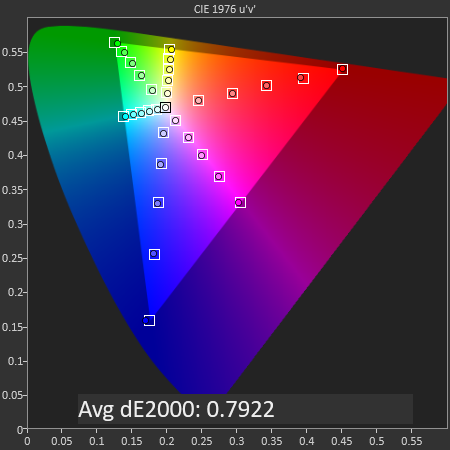
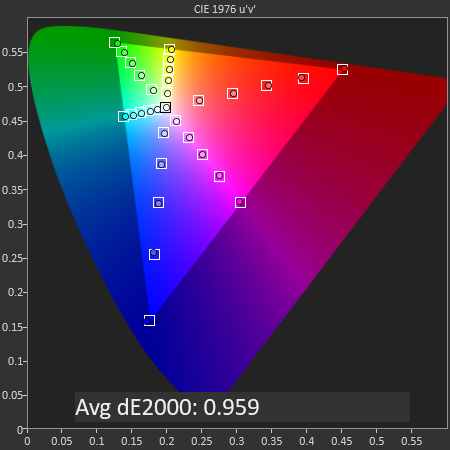
iPhone XS - iPhone XS Max
SpectraCal CalMAN
By default, the XS display and software interpret non-wide gamut tagged content as sRGB. Measuring the saturation accuracy here, we see some amazing results from both phones. The XS posted an amazing dE2000 of 0.79 – this is so low that it’s nigh-impossible to get much better, even when manually calibrating a display. The XS Max fared a bit worse at 0.95, but still below 1 which still deserves it the commendation of being excellently accurate.
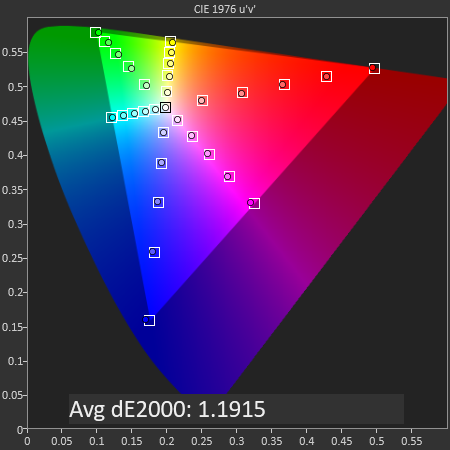
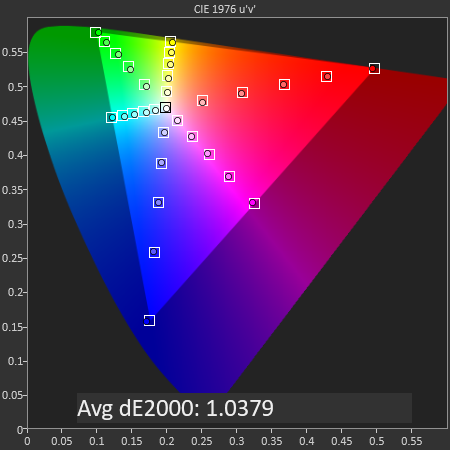
iPhone XS - iPhone XS Max
SpectraCal CalMAN
When the application supports it, and the media has a wide gamut profile embedded, the iPhone XS displays are able to showcase the higher colour intensities of this wider colour gamut. Apple pretty much standardised “Display P3” in the mobile world – a display mode with the gamut of DCI P3, yet with an identical gamma target of 2.2 of sRGB, ensuring seamless interoperability of both gamuts within a display.
Again, both the iPhone XS and the XS Max showcase outstanding calibration with respective dE2000 of 1.19 and 1.03.
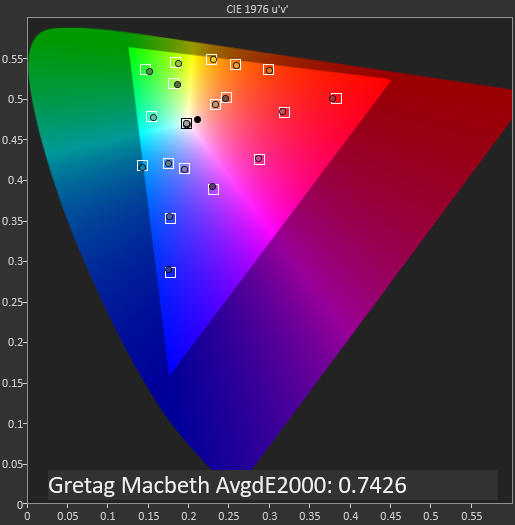
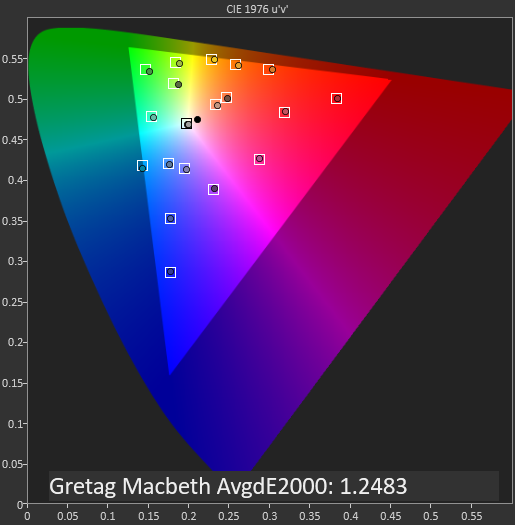
iPhone XS - iPhone XS Max
SpectraCal CalMAN


iPhone XS - iPhone XS Max
SpectraCal CalMAN
The Gretag Macbeth colour targets contain commonly encountered colours, such as skin tones and other colour samples. This test checks not only if the display is able to display the correct colour hue, but also the luminosity.
Again, the iPhones are able to show outstanding figures. The 0.74 score of the iPhone XS is I think the lowest figure we’ve measured on any kind of display, which is amazing. My XS Max figures scored a bit worse, it’s likely that the green channel weakness is part of what’s causing it to be better.
Overall, the iPhone displays are just outstanding. These are the best calibration results we’ve come to measure not only in a smartphone, but likely any display. I have literally nothing negative to say about them, and in terms of picture quality, they are just the best displays on the market.
Display Power
I was curious to see how the new XS fared against last year’s X – as it’s possible there might have been some under-the-hood improvements in terms of panel or emitter materials.
Unfortunately, it looks like the iPhone XS is nigh identical to the iPhone X when it comes to the power characteristics of the panel. My iPhone X had reached just a bit higher brightness and extended up the power curve a bit, but otherwise any differences can just as well be attributed to random manufacturing fluctuations.
| Screen Luminance Power Efficiency 100% APL / White @ 200nits |
||||||
| Device | Screen Luminance Power at 200cd/m² |
Luminance Power (mW) / Screen area (cm²) Efficiency |
||||
| LG G7 | 257 mW | 2.93 | ||||
| LG G6 | 363 mW | 4.43 | ||||
| P20 | 411 mW | 4.86 | ||||
| Galaxy S9 | 563 mW | 6.69 | ||||
| P20 Pro | 601 mW | 6.74 | ||||
| Galaxy S8 | 590 mW | 7.01 | ||||
| iPhone X | ~671 mW | ~8.31 | ||||
| iPhone XS | ~736 mW | ~9.11 | ||||
Comparing the power efficiency at 200cd/m² and normalising the luminance power of the devices for their screen area, we see that the iPhone X and XS fall a tad behind other Samsung OLED panels. I think what this could be attributed to is the 10-bit colour depth of the Apple phones, as their DDIC and the active matrix would need to do more work versus the 8-bit counterparts.
One thing to also very much to take into account is the base power consumption of the phones. The iPhone X, XS and XS Max all fluctuate around 480-500 mW when on a black screen, which is around 150mW more than the iPhone 8 LCD models. This might not sound much, but’s it’s an absolutely huge figure when taking into account that it’s an unavoidable power consumption of the phone whenever the screen is on. I do hope Samsung and Apple alike would be able to focus more on optimising this, as like we’re about to see, it will have an impact on battery life.


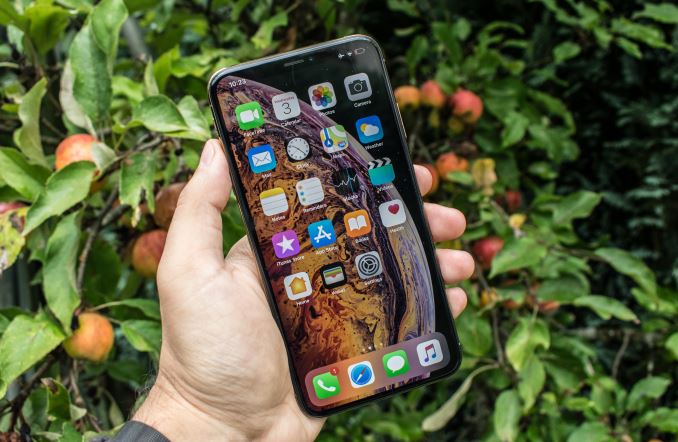
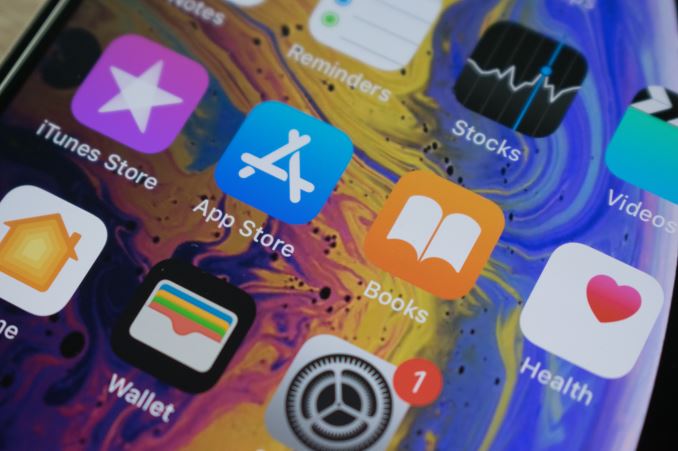
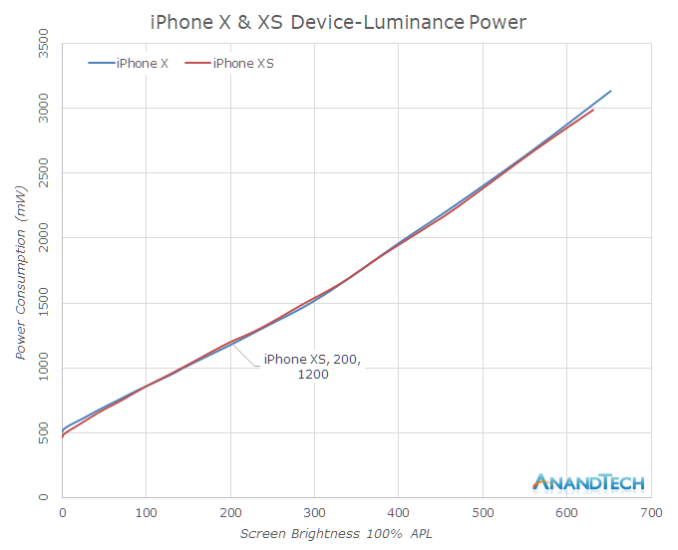








253 Comments
View All Comments
Andrei Frumusanu - Saturday, October 6, 2018 - link
Eh no, it's single thread comparisons everywhere.Alistair - Saturday, October 6, 2018 - link
Thank you for making that clear. See my below comment with links, I put your data into a chart to compare. Is it fair to say IPC for the A12 in integers, is up to 64 percent faster?Hifihedgehog - Saturday, October 6, 2018 - link
Awesome! Thanks for the clarification. So my own education, is SPECint2006 a single-threaded test by its very nature? Can it be configured for multithreaded as well? If so, do you have multithreaded results forthcoming as well? I would love to see where Apple falls in this benchmark in that area as well.Andrei Frumusanu - Saturday, October 6, 2018 - link
SPECspeed is the score of running a single instance, SPECrate is running as many as there are cores on a system.It's not possible to run SPECrate on iOS anyhow without some very major hacky modifications of the benchmark because of the way it's ported without running in its own process. For Android devices it's possible, but I never really saw much interest or value for it.
Hifihedgehog - Saturday, October 6, 2018 - link
What about joules and watts? This is what is confusing me now. Something that seems a bit suspect to me is that the average energy and joule totals are not consistently lower together. That is, expect a device that has a lower average power usage to over the duration of the test to draw less total joules of energy. Mathematically speaking, I would naturally expect this especially in the case of higher benchmark scores since the lower power would be over a shorter space of time, meaning less total energy drawn.Andrei Frumusanu - Saturday, October 6, 2018 - link
The amount of Joules drawn depends on the average power and performance (time) of the benchmark.If a CPU uses 4 watts and gives 20 performance (say 5 minute to complete), it will use less energy than a CPU using 2 watts and giving 8 performance (12.5 minutes to complete), for example.
Dredd67 - Saturday, October 6, 2018 - link
I live in France and have to deal with intel radios since a while. I'm totally baffled to read all the comments about poor reception, dropped calls, wifi going crazy like this is news.This problem has been there since the beginning of Apple using intel chips ! It's just now that Americans have to use them also that it might finallybe adressed (please keep complaining, raise awareness, file a class action, whatever it takes) but you don't realize the pain these past years have been using an iphone elsewhere in the world...
For the record, I just gave my 7 (intel chip) to my daughter who broke here phone and reverted back to an old 6plus I kept for such cases (it also uses qualcomm). In the family I'm now the only only getting rock solid wifi, no dropped calls, consistent signal strenght, on a 4+ years old phone. And all this time I thought my carrier was messing around, my orbis were crap, or I just fumbled with my router settings.
Shame on you Apple, shame on you.
Oh and don't get me started on the camera: is this really what people want ? I think it's getting worse and worse, not better. Completely artifical images, looking more like cartoons than photographs. Same for Samsung and Google's phones. Hav a look at the P20 pro for a reality check. This is what photos should look like (contrast, colors - not really dependant on the sensor size).
Great review though.
ex2bot - Sunday, October 7, 2018 - link
The Halite app devs showed off an interesting technique they’re using or working on for the XS they call SmartRAW that may offer more control over the over saturation / lower contrast issues, etc.s.yu - Monday, October 8, 2018 - link
"Hav a look at the P20 pro for a reality check."?Your reality is the smeared textureless crap with oversharpening contours along object edges? Unbelievable.
serendip - Saturday, October 6, 2018 - link
Could these amazing CPU gains be translated to a midrange chip? Technically Android could run on Apple SoCs because they're all ARM licensed cores but porcines would gain flying abilities before that ever happened.It's too bad Android users are stuck with the best that ARM and Qualcomm can do, which isn't much compared to Apple's semi design team.